Unit 2: Managing Financial Resources & Decisions HND - LSST
VerifiedAdded on 2023/04/26
|28
|7600
|379
Report
AI Summary
This report, submitted for a Level 4 HND Business course at the London School of Science & Technology, focuses on managing financial resources and decisions. It identifies and describes various sources of finance available to businesses in the UK, including banks, grants, business angels, personal finance, loans, and CDFAs, assessing their implications, costs, advantages, and disadvantages. The report analyzes the suitability of these financial sources for a hypothetical new business venture involved in producing equipment for educational institutions, considering bank loans, angel investors, and government grants. It further explains the importance of financial planning for business success, highlighting its role in efficient fund management, cash flow improvement, and risk reduction. Finally, the report identifies the main users of financial information and assesses their diverse information needs, emphasizing the significance of financial statements in informing stakeholders about a company's financial health and operations. Desklib provides access to this and other solved assignments.
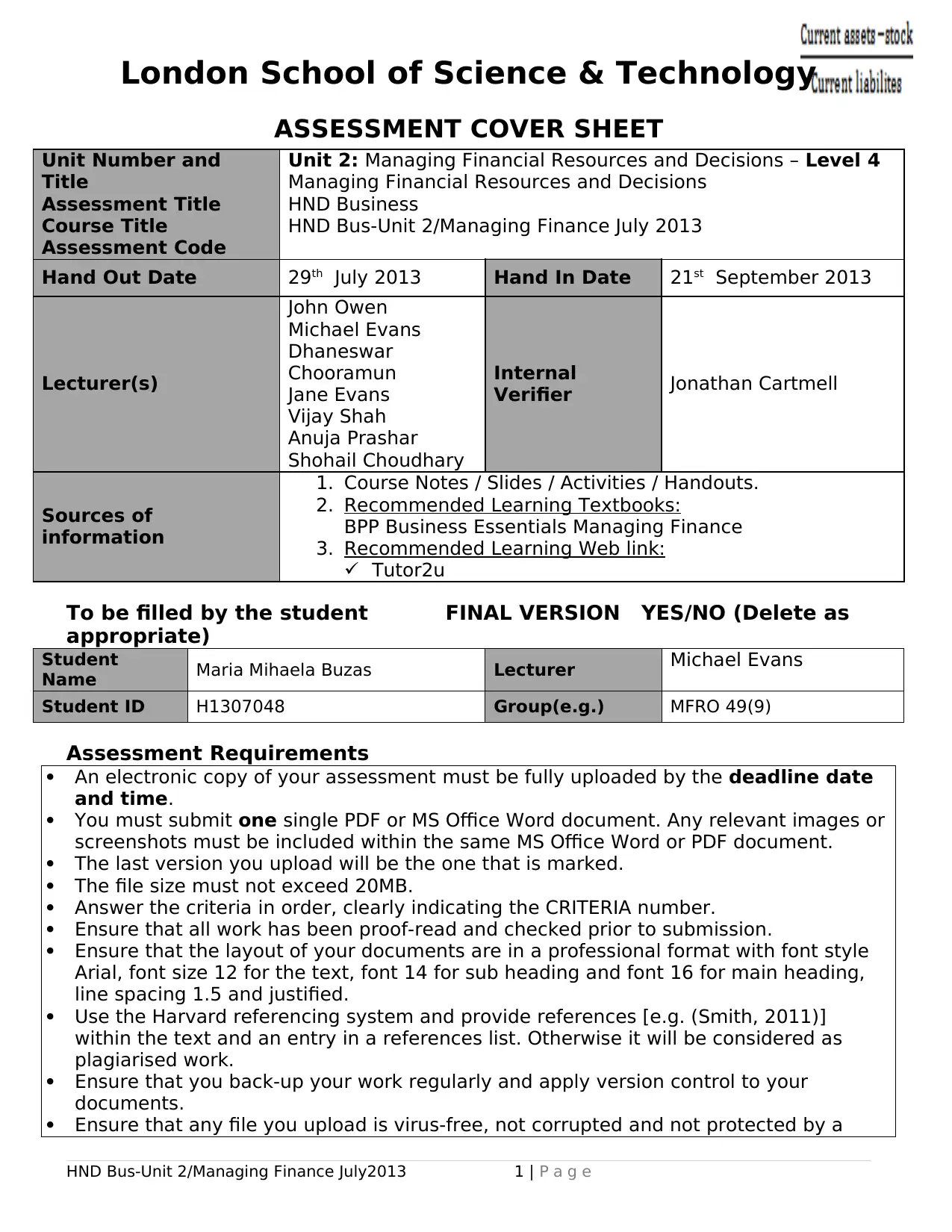
London School of Science & Technology
ASSESSMENT COVER SHEET
Unit Number and
Title
Assessment Title
Course Title
Assessment Code
Unit 2: Managing Financial Resources and Decisions – Level 4
Managing Financial Resources and Decisions
HND Business
HND Bus-Unit 2/Managing Finance July 2013
Hand Out Date 29th July 2013 Hand In Date 21st September 2013
Lecturer(s)
John Owen
Michael Evans
Dhaneswar
Chooramun
Jane Evans
Vijay Shah
Anuja Prashar
Shohail Choudhary
Internal
Verifier Jonathan Cartmell
Sources of
information
1. Course Notes / Slides / Activities / Handouts.
2. Recommended Learning Textbooks:
BPP Business Essentials Managing Finance
3. Recommended Learning Web link:
Tutor2u
To be filled by the student FINAL VERSION YES/NO (Delete as
appropriate)
Student
Name Maria Mihaela Buzas Lecturer Michael Evans
Student ID H1307048 Group(e.g.) MFRO 49(9)
Assessment Requirements
An electronic copy of your assessment must be fully uploaded by the deadline date
and time.
You must submit one single PDF or MS Office Word document. Any relevant images or
screenshots must be included within the same MS Office Word or PDF document.
The last version you upload will be the one that is marked.
The file size must not exceed 20MB.
Answer the criteria in order, clearly indicating the CRITERIA number.
Ensure that all work has been proof-read and checked prior to submission.
Ensure that the layout of your documents are in a professional format with font style
Arial, font size 12 for the text, font 14 for sub heading and font 16 for main heading,
line spacing 1.5 and justified.
Use the Harvard referencing system and provide references [e.g. (Smith, 2011)]
within the text and an entry in a references list. Otherwise it will be considered as
plagiarised work.
Ensure that you back-up your work regularly and apply version control to your
documents.
Ensure that any file you upload is virus-free, not corrupted and not protected by a
HND Bus-Unit 2/Managing Finance July2013 1 | P a g e
ASSESSMENT COVER SHEET
Unit Number and
Title
Assessment Title
Course Title
Assessment Code
Unit 2: Managing Financial Resources and Decisions – Level 4
Managing Financial Resources and Decisions
HND Business
HND Bus-Unit 2/Managing Finance July 2013
Hand Out Date 29th July 2013 Hand In Date 21st September 2013
Lecturer(s)
John Owen
Michael Evans
Dhaneswar
Chooramun
Jane Evans
Vijay Shah
Anuja Prashar
Shohail Choudhary
Internal
Verifier Jonathan Cartmell
Sources of
information
1. Course Notes / Slides / Activities / Handouts.
2. Recommended Learning Textbooks:
BPP Business Essentials Managing Finance
3. Recommended Learning Web link:
Tutor2u
To be filled by the student FINAL VERSION YES/NO (Delete as
appropriate)
Student
Name Maria Mihaela Buzas Lecturer Michael Evans
Student ID H1307048 Group(e.g.) MFRO 49(9)
Assessment Requirements
An electronic copy of your assessment must be fully uploaded by the deadline date
and time.
You must submit one single PDF or MS Office Word document. Any relevant images or
screenshots must be included within the same MS Office Word or PDF document.
The last version you upload will be the one that is marked.
The file size must not exceed 20MB.
Answer the criteria in order, clearly indicating the CRITERIA number.
Ensure that all work has been proof-read and checked prior to submission.
Ensure that the layout of your documents are in a professional format with font style
Arial, font size 12 for the text, font 14 for sub heading and font 16 for main heading,
line spacing 1.5 and justified.
Use the Harvard referencing system and provide references [e.g. (Smith, 2011)]
within the text and an entry in a references list. Otherwise it will be considered as
plagiarised work.
Ensure that you back-up your work regularly and apply version control to your
documents.
Ensure that any file you upload is virus-free, not corrupted and not protected by a
HND Bus-Unit 2/Managing Finance July2013 1 | P a g e
Paraphrase This Document
Need a fresh take? Get an instant paraphrase of this document with our AI Paraphraser
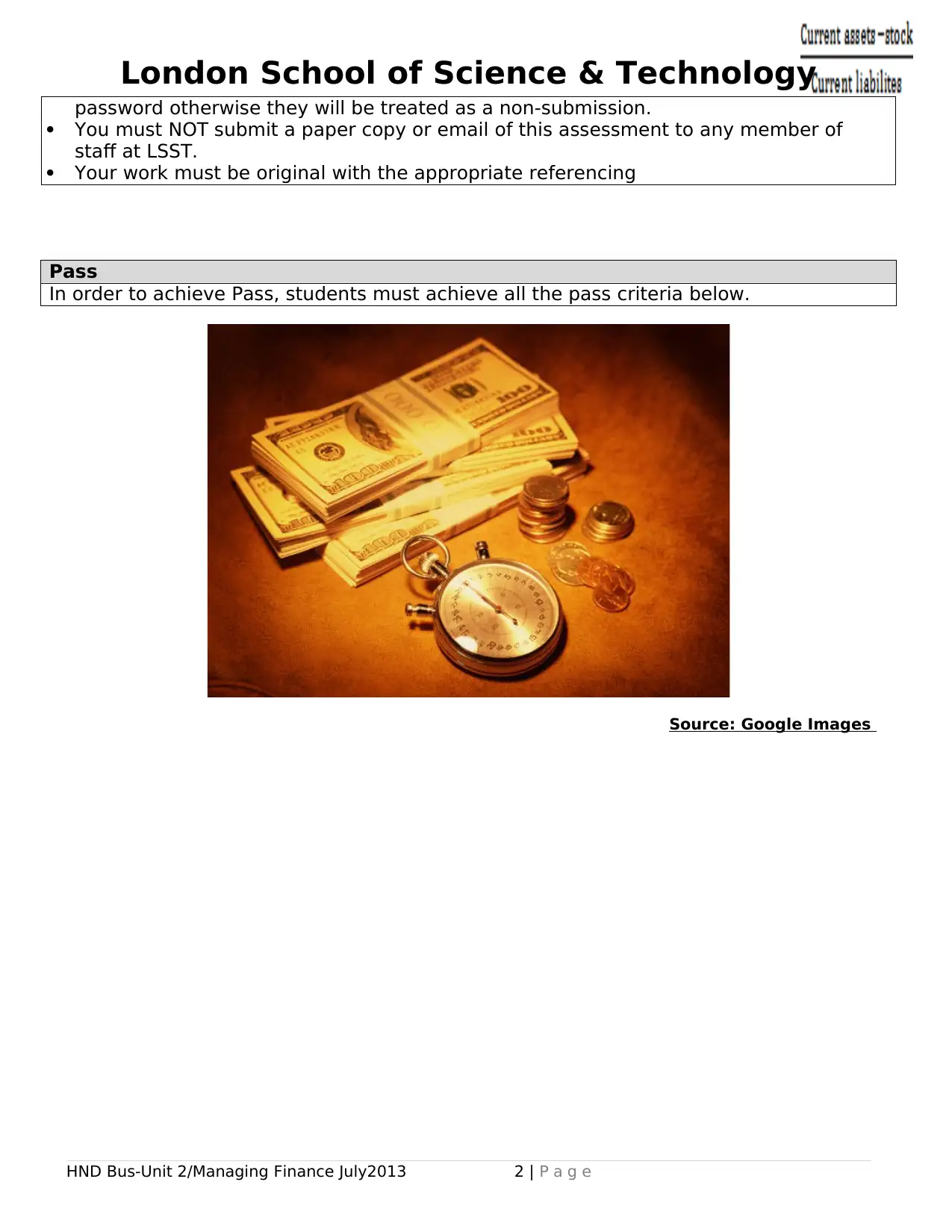
London School of Science & Technology
password otherwise they will be treated as a non-submission.
You must NOT submit a paper copy or email of this assessment to any member of
staff at LSST.
Your work must be original with the appropriate referencing
Pass
In order to achieve Pass, students must achieve all the pass criteria below.
Source: Google Images
HND Bus-Unit 2/Managing Finance July2013 2 | P a g e
password otherwise they will be treated as a non-submission.
You must NOT submit a paper copy or email of this assessment to any member of
staff at LSST.
Your work must be original with the appropriate referencing
Pass
In order to achieve Pass, students must achieve all the pass criteria below.
Source: Google Images
HND Bus-Unit 2/Managing Finance July2013 2 | P a g e
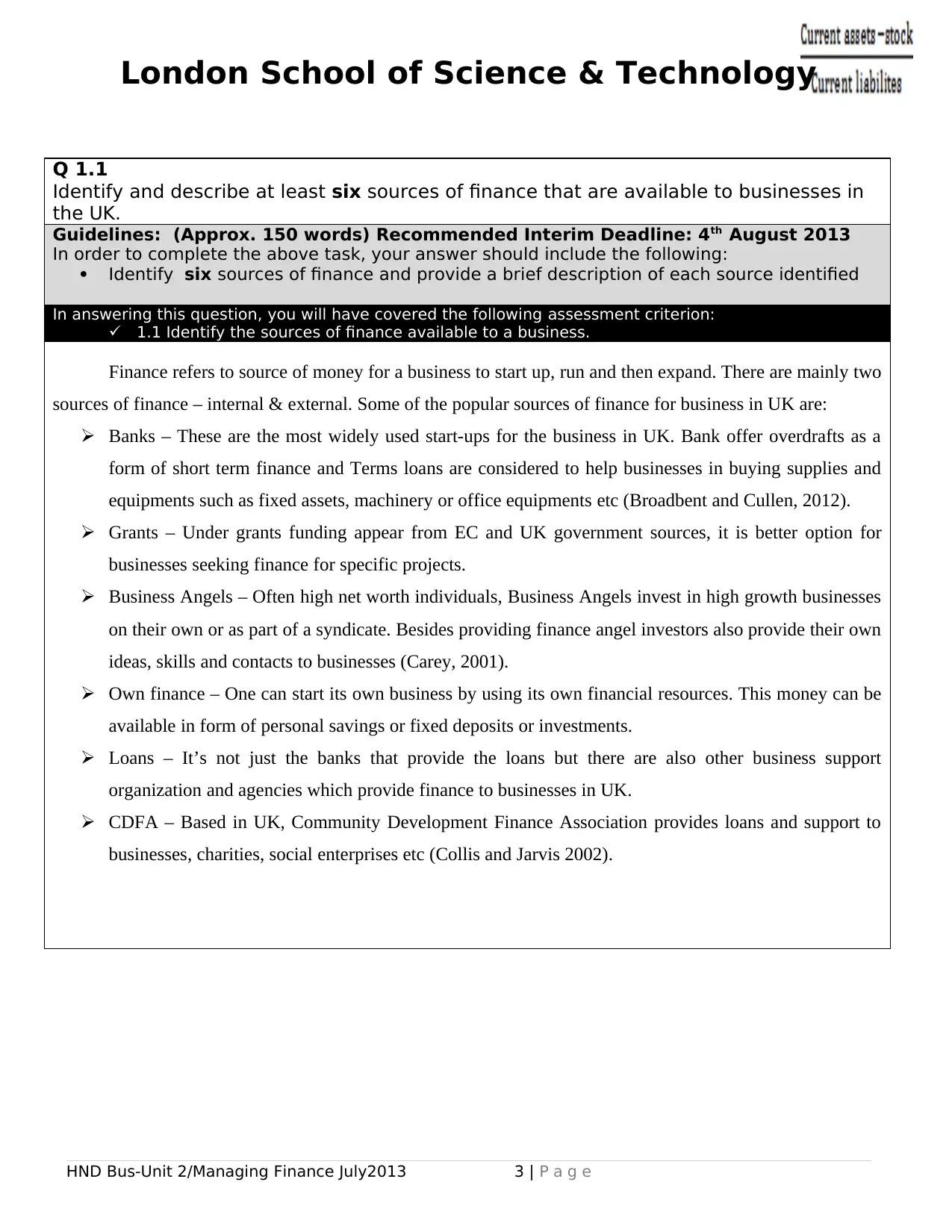
London School of Science & Technology
Q 1.1
Identify and describe at least six sources of finance that are available to businesses in
the UK.
Guidelines: (Approx. 150 words) Recommended Interim Deadline: 4th August 2013
In order to complete the above task, your answer should include the following:
Identify six sources of finance and provide a brief description of each source identified
In answering this question, you will have covered the following assessment criterion:
1.1 Identify the sources of finance available to a business.
Finance refers to source of money for a business to start up, run and then expand. There are mainly two
sources of finance – internal & external. Some of the popular sources of finance for business in UK are:
Banks – These are the most widely used start-ups for the business in UK. Bank offer overdrafts as a
form of short term finance and Terms loans are considered to help businesses in buying supplies and
equipments such as fixed assets, machinery or office equipments etc (Broadbent and Cullen, 2012).
Grants – Under grants funding appear from EC and UK government sources, it is better option for
businesses seeking finance for specific projects.
Business Angels – Often high net worth individuals, Business Angels invest in high growth businesses
on their own or as part of a syndicate. Besides providing finance angel investors also provide their own
ideas, skills and contacts to businesses (Carey, 2001).
Own finance – One can start its own business by using its own financial resources. This money can be
available in form of personal savings or fixed deposits or investments.
Loans – It’s not just the banks that provide the loans but there are also other business support
organization and agencies which provide finance to businesses in UK.
CDFA – Based in UK, Community Development Finance Association provides loans and support to
businesses, charities, social enterprises etc (Collis and Jarvis 2002).
HND Bus-Unit 2/Managing Finance July2013 3 | P a g e
Q 1.1
Identify and describe at least six sources of finance that are available to businesses in
the UK.
Guidelines: (Approx. 150 words) Recommended Interim Deadline: 4th August 2013
In order to complete the above task, your answer should include the following:
Identify six sources of finance and provide a brief description of each source identified
In answering this question, you will have covered the following assessment criterion:
1.1 Identify the sources of finance available to a business.
Finance refers to source of money for a business to start up, run and then expand. There are mainly two
sources of finance – internal & external. Some of the popular sources of finance for business in UK are:
Banks – These are the most widely used start-ups for the business in UK. Bank offer overdrafts as a
form of short term finance and Terms loans are considered to help businesses in buying supplies and
equipments such as fixed assets, machinery or office equipments etc (Broadbent and Cullen, 2012).
Grants – Under grants funding appear from EC and UK government sources, it is better option for
businesses seeking finance for specific projects.
Business Angels – Often high net worth individuals, Business Angels invest in high growth businesses
on their own or as part of a syndicate. Besides providing finance angel investors also provide their own
ideas, skills and contacts to businesses (Carey, 2001).
Own finance – One can start its own business by using its own financial resources. This money can be
available in form of personal savings or fixed deposits or investments.
Loans – It’s not just the banks that provide the loans but there are also other business support
organization and agencies which provide finance to businesses in UK.
CDFA – Based in UK, Community Development Finance Association provides loans and support to
businesses, charities, social enterprises etc (Collis and Jarvis 2002).
HND Bus-Unit 2/Managing Finance July2013 3 | P a g e
⊘ This is a preview!⊘
Do you want full access?
Subscribe today to unlock all pages.

Trusted by 1+ million students worldwide
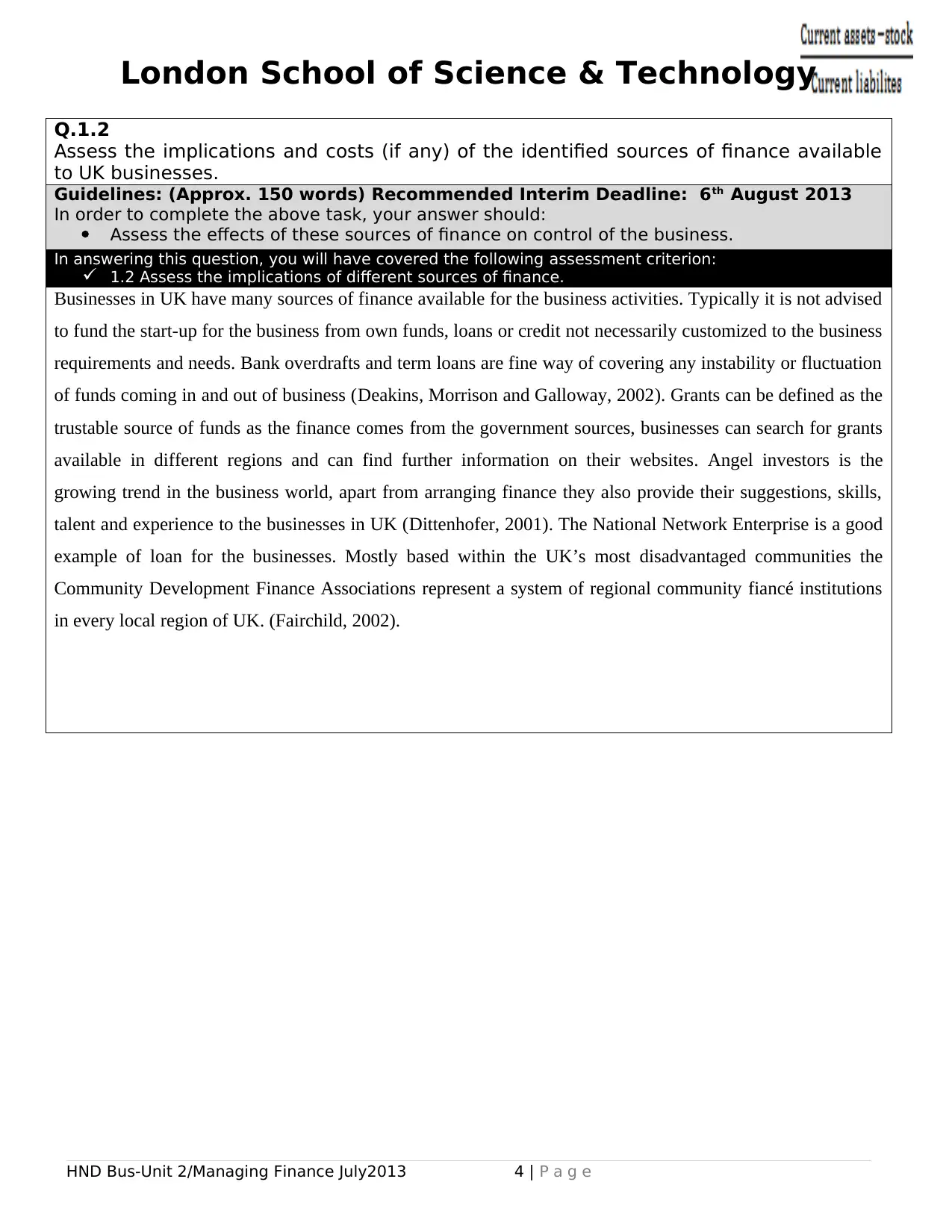
London School of Science & Technology
Q.1.2
Assess the implications and costs (if any) of the identified sources of finance available
to UK businesses.
Guidelines: (Approx. 150 words) Recommended Interim Deadline: 6th August 2013
In order to complete the above task, your answer should:
Assess the effects of these sources of finance on control of the business.
In answering this question, you will have covered the following assessment criterion:
1.2 Assess the implications of different sources of finance.
Businesses in UK have many sources of finance available for the business activities. Typically it is not advised
to fund the start-up for the business from own funds, loans or credit not necessarily customized to the business
requirements and needs. Bank overdrafts and term loans are fine way of covering any instability or fluctuation
of funds coming in and out of business (Deakins, Morrison and Galloway, 2002). Grants can be defined as the
trustable source of funds as the finance comes from the government sources, businesses can search for grants
available in different regions and can find further information on their websites. Angel investors is the
growing trend in the business world, apart from arranging finance they also provide their suggestions, skills,
talent and experience to the businesses in UK (Dittenhofer, 2001). The National Network Enterprise is a good
example of loan for the businesses. Mostly based within the UK’s most disadvantaged communities the
Community Development Finance Associations represent a system of regional community fiancé institutions
in every local region of UK. (Fairchild, 2002).
HND Bus-Unit 2/Managing Finance July2013 4 | P a g e
Q.1.2
Assess the implications and costs (if any) of the identified sources of finance available
to UK businesses.
Guidelines: (Approx. 150 words) Recommended Interim Deadline: 6th August 2013
In order to complete the above task, your answer should:
Assess the effects of these sources of finance on control of the business.
In answering this question, you will have covered the following assessment criterion:
1.2 Assess the implications of different sources of finance.
Businesses in UK have many sources of finance available for the business activities. Typically it is not advised
to fund the start-up for the business from own funds, loans or credit not necessarily customized to the business
requirements and needs. Bank overdrafts and term loans are fine way of covering any instability or fluctuation
of funds coming in and out of business (Deakins, Morrison and Galloway, 2002). Grants can be defined as the
trustable source of funds as the finance comes from the government sources, businesses can search for grants
available in different regions and can find further information on their websites. Angel investors is the
growing trend in the business world, apart from arranging finance they also provide their suggestions, skills,
talent and experience to the businesses in UK (Dittenhofer, 2001). The National Network Enterprise is a good
example of loan for the businesses. Mostly based within the UK’s most disadvantaged communities the
Community Development Finance Associations represent a system of regional community fiancé institutions
in every local region of UK. (Fairchild, 2002).
HND Bus-Unit 2/Managing Finance July2013 4 | P a g e
Paraphrase This Document
Need a fresh take? Get an instant paraphrase of this document with our AI Paraphraser
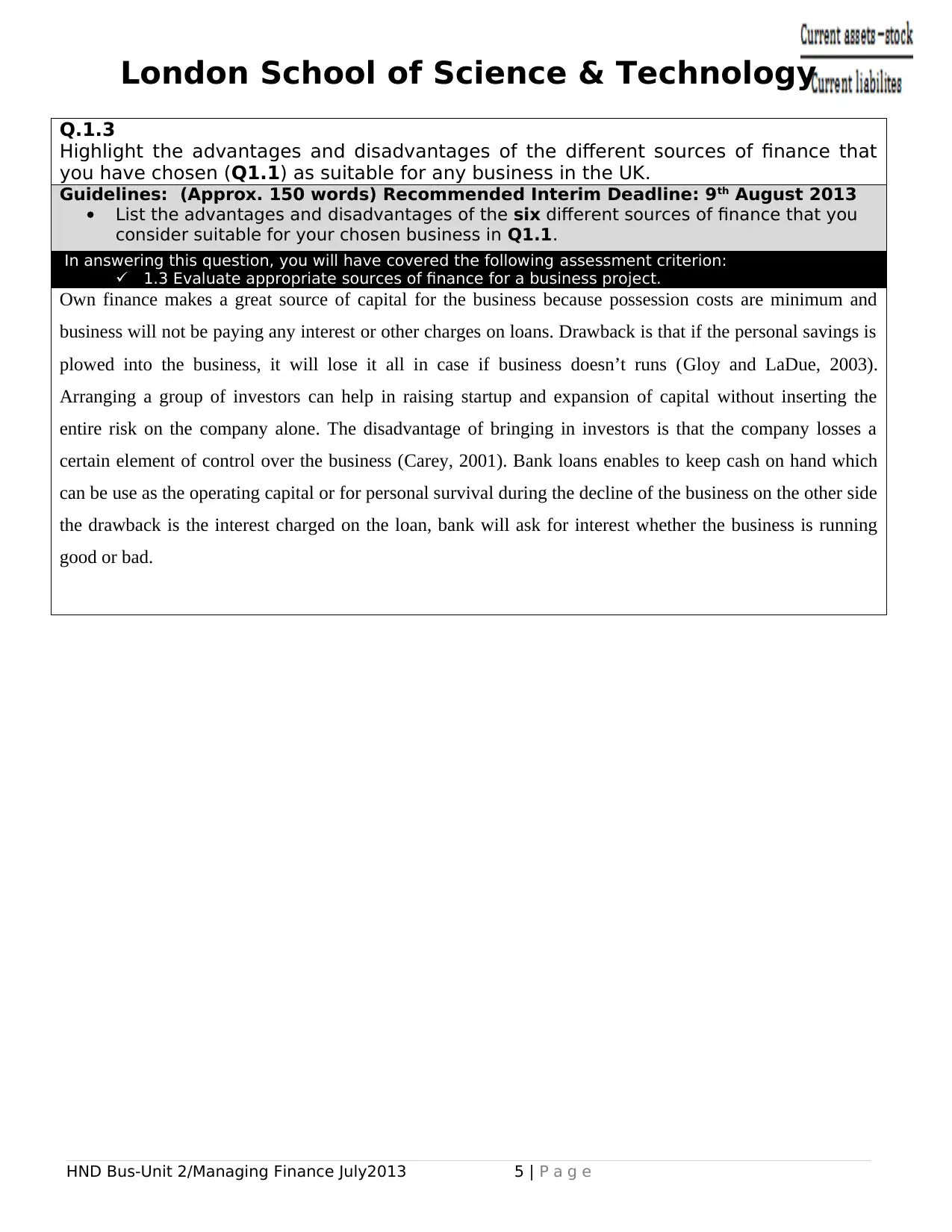
London School of Science & Technology
Q.1.3
Highlight the advantages and disadvantages of the different sources of finance that
you have chosen (Q1.1) as suitable for any business in the UK.
Guidelines: (Approx. 150 words) Recommended Interim Deadline: 9th August 2013
List the advantages and disadvantages of the six different sources of finance that you
consider suitable for your chosen business in Q1.1.
In answering this question, you will have covered the following assessment criterion:
1.3 Evaluate appropriate sources of finance for a business project.
Own finance makes a great source of capital for the business because possession costs are minimum and
business will not be paying any interest or other charges on loans. Drawback is that if the personal savings is
plowed into the business, it will lose it all in case if business doesn’t runs (Gloy and LaDue, 2003).
Arranging a group of investors can help in raising startup and expansion of capital without inserting the
entire risk on the company alone. The disadvantage of bringing in investors is that the company losses a
certain element of control over the business (Carey, 2001). Bank loans enables to keep cash on hand which
can be use as the operating capital or for personal survival during the decline of the business on the other side
the drawback is the interest charged on the loan, bank will ask for interest whether the business is running
good or bad.
HND Bus-Unit 2/Managing Finance July2013 5 | P a g e
Q.1.3
Highlight the advantages and disadvantages of the different sources of finance that
you have chosen (Q1.1) as suitable for any business in the UK.
Guidelines: (Approx. 150 words) Recommended Interim Deadline: 9th August 2013
List the advantages and disadvantages of the six different sources of finance that you
consider suitable for your chosen business in Q1.1.
In answering this question, you will have covered the following assessment criterion:
1.3 Evaluate appropriate sources of finance for a business project.
Own finance makes a great source of capital for the business because possession costs are minimum and
business will not be paying any interest or other charges on loans. Drawback is that if the personal savings is
plowed into the business, it will lose it all in case if business doesn’t runs (Gloy and LaDue, 2003).
Arranging a group of investors can help in raising startup and expansion of capital without inserting the
entire risk on the company alone. The disadvantage of bringing in investors is that the company losses a
certain element of control over the business (Carey, 2001). Bank loans enables to keep cash on hand which
can be use as the operating capital or for personal survival during the decline of the business on the other side
the drawback is the interest charged on the loan, bank will ask for interest whether the business is running
good or bad.
HND Bus-Unit 2/Managing Finance July2013 5 | P a g e
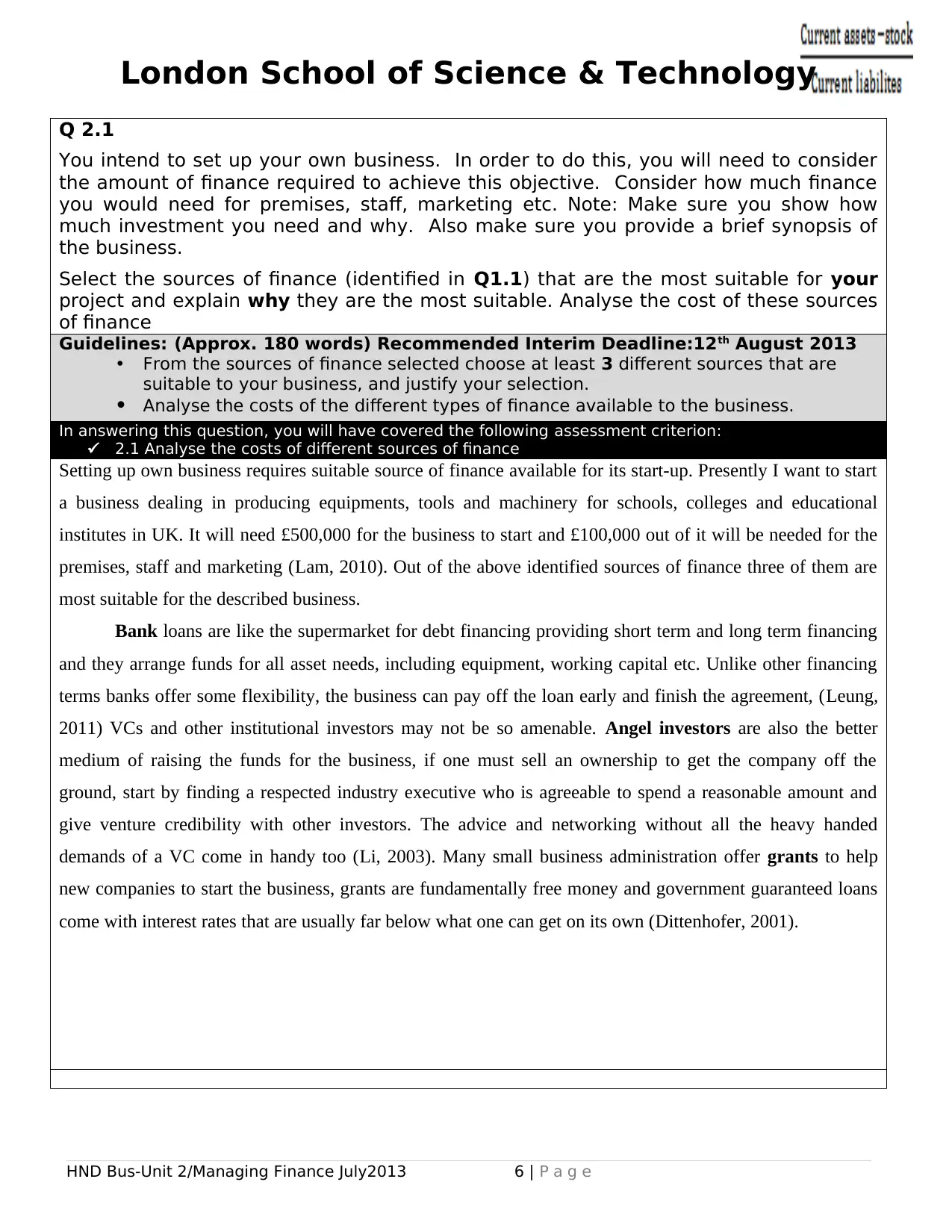
London School of Science & Technology
Q 2.1
You intend to set up your own business. In order to do this, you will need to consider
the amount of finance required to achieve this objective. Consider how much finance
you would need for premises, staff, marketing etc. Note: Make sure you show how
much investment you need and why. Also make sure you provide a brief synopsis of
the business.
Select the sources of finance (identified in Q1.1) that are the most suitable for your
project and explain why they are the most suitable. Analyse the cost of these sources
of finance
Guidelines: (Approx. 180 words) Recommended Interim Deadline:12th August 2013
• From the sources of finance selected choose at least 3 different sources that are
suitable to your business, and justify your selection.
• Analyse the costs of the different types of finance available to the business.
In answering this question, you will have covered the following assessment criterion:
2.1 Analyse the costs of different sources of finance
Setting up own business requires suitable source of finance available for its start-up. Presently I want to start
a business dealing in producing equipments, tools and machinery for schools, colleges and educational
institutes in UK. It will need £500,000 for the business to start and £100,000 out of it will be needed for the
premises, staff and marketing (Lam, 2010). Out of the above identified sources of finance three of them are
most suitable for the described business.
Bank loans are like the supermarket for debt financing providing short term and long term financing
and they arrange funds for all asset needs, including equipment, working capital etc. Unlike other financing
terms banks offer some flexibility, the business can pay off the loan early and finish the agreement, (Leung,
2011) VCs and other institutional investors may not be so amenable. Angel investors are also the better
medium of raising the funds for the business, if one must sell an ownership to get the company off the
ground, start by finding a respected industry executive who is agreeable to spend a reasonable amount and
give venture credibility with other investors. The advice and networking without all the heavy handed
demands of a VC come in handy too (Li, 2003). Many small business administration offer grants to help
new companies to start the business, grants are fundamentally free money and government guaranteed loans
come with interest rates that are usually far below what one can get on its own (Dittenhofer, 2001).
HND Bus-Unit 2/Managing Finance July2013 6 | P a g e
Q 2.1
You intend to set up your own business. In order to do this, you will need to consider
the amount of finance required to achieve this objective. Consider how much finance
you would need for premises, staff, marketing etc. Note: Make sure you show how
much investment you need and why. Also make sure you provide a brief synopsis of
the business.
Select the sources of finance (identified in Q1.1) that are the most suitable for your
project and explain why they are the most suitable. Analyse the cost of these sources
of finance
Guidelines: (Approx. 180 words) Recommended Interim Deadline:12th August 2013
• From the sources of finance selected choose at least 3 different sources that are
suitable to your business, and justify your selection.
• Analyse the costs of the different types of finance available to the business.
In answering this question, you will have covered the following assessment criterion:
2.1 Analyse the costs of different sources of finance
Setting up own business requires suitable source of finance available for its start-up. Presently I want to start
a business dealing in producing equipments, tools and machinery for schools, colleges and educational
institutes in UK. It will need £500,000 for the business to start and £100,000 out of it will be needed for the
premises, staff and marketing (Lam, 2010). Out of the above identified sources of finance three of them are
most suitable for the described business.
Bank loans are like the supermarket for debt financing providing short term and long term financing
and they arrange funds for all asset needs, including equipment, working capital etc. Unlike other financing
terms banks offer some flexibility, the business can pay off the loan early and finish the agreement, (Leung,
2011) VCs and other institutional investors may not be so amenable. Angel investors are also the better
medium of raising the funds for the business, if one must sell an ownership to get the company off the
ground, start by finding a respected industry executive who is agreeable to spend a reasonable amount and
give venture credibility with other investors. The advice and networking without all the heavy handed
demands of a VC come in handy too (Li, 2003). Many small business administration offer grants to help
new companies to start the business, grants are fundamentally free money and government guaranteed loans
come with interest rates that are usually far below what one can get on its own (Dittenhofer, 2001).
HND Bus-Unit 2/Managing Finance July2013 6 | P a g e
⊘ This is a preview!⊘
Do you want full access?
Subscribe today to unlock all pages.

Trusted by 1+ million students worldwide
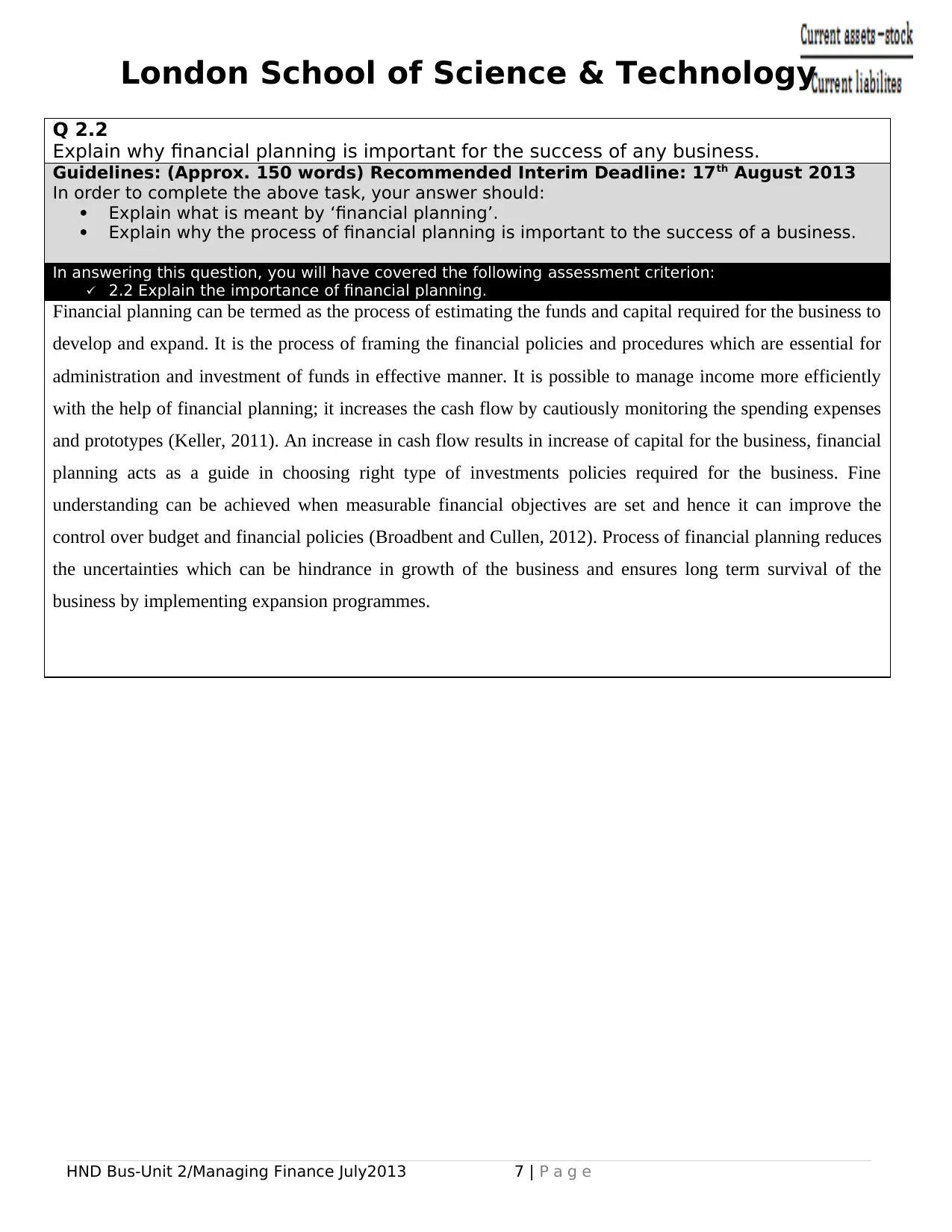
London School of Science & Technology
Q 2.2
Explain why financial planning is important for the success of any business.
Guidelines: (Approx. 150 words) Recommended Interim Deadline: 17th August 2013
In order to complete the above task, your answer should:
Explain what is meant by ‘financial planning’.
Explain why the process of financial planning is important to the success of a business.
In answering this question, you will have covered the following assessment criterion:
2.2 Explain the importance of financial planning.
Financial planning can be termed as the process of estimating the funds and capital required for the business to
develop and expand. It is the process of framing the financial policies and procedures which are essential for
administration and investment of funds in effective manner. It is possible to manage income more efficiently
with the help of financial planning; it increases the cash flow by cautiously monitoring the spending expenses
and prototypes (Keller, 2011). An increase in cash flow results in increase of capital for the business, financial
planning acts as a guide in choosing right type of investments policies required for the business. Fine
understanding can be achieved when measurable financial objectives are set and hence it can improve the
control over budget and financial policies (Broadbent and Cullen, 2012). Process of financial planning reduces
the uncertainties which can be hindrance in growth of the business and ensures long term survival of the
business by implementing expansion programmes.
HND Bus-Unit 2/Managing Finance July2013 7 | P a g e
Q 2.2
Explain why financial planning is important for the success of any business.
Guidelines: (Approx. 150 words) Recommended Interim Deadline: 17th August 2013
In order to complete the above task, your answer should:
Explain what is meant by ‘financial planning’.
Explain why the process of financial planning is important to the success of a business.
In answering this question, you will have covered the following assessment criterion:
2.2 Explain the importance of financial planning.
Financial planning can be termed as the process of estimating the funds and capital required for the business to
develop and expand. It is the process of framing the financial policies and procedures which are essential for
administration and investment of funds in effective manner. It is possible to manage income more efficiently
with the help of financial planning; it increases the cash flow by cautiously monitoring the spending expenses
and prototypes (Keller, 2011). An increase in cash flow results in increase of capital for the business, financial
planning acts as a guide in choosing right type of investments policies required for the business. Fine
understanding can be achieved when measurable financial objectives are set and hence it can improve the
control over budget and financial policies (Broadbent and Cullen, 2012). Process of financial planning reduces
the uncertainties which can be hindrance in growth of the business and ensures long term survival of the
business by implementing expansion programmes.
HND Bus-Unit 2/Managing Finance July2013 7 | P a g e
Paraphrase This Document
Need a fresh take? Get an instant paraphrase of this document with our AI Paraphraser
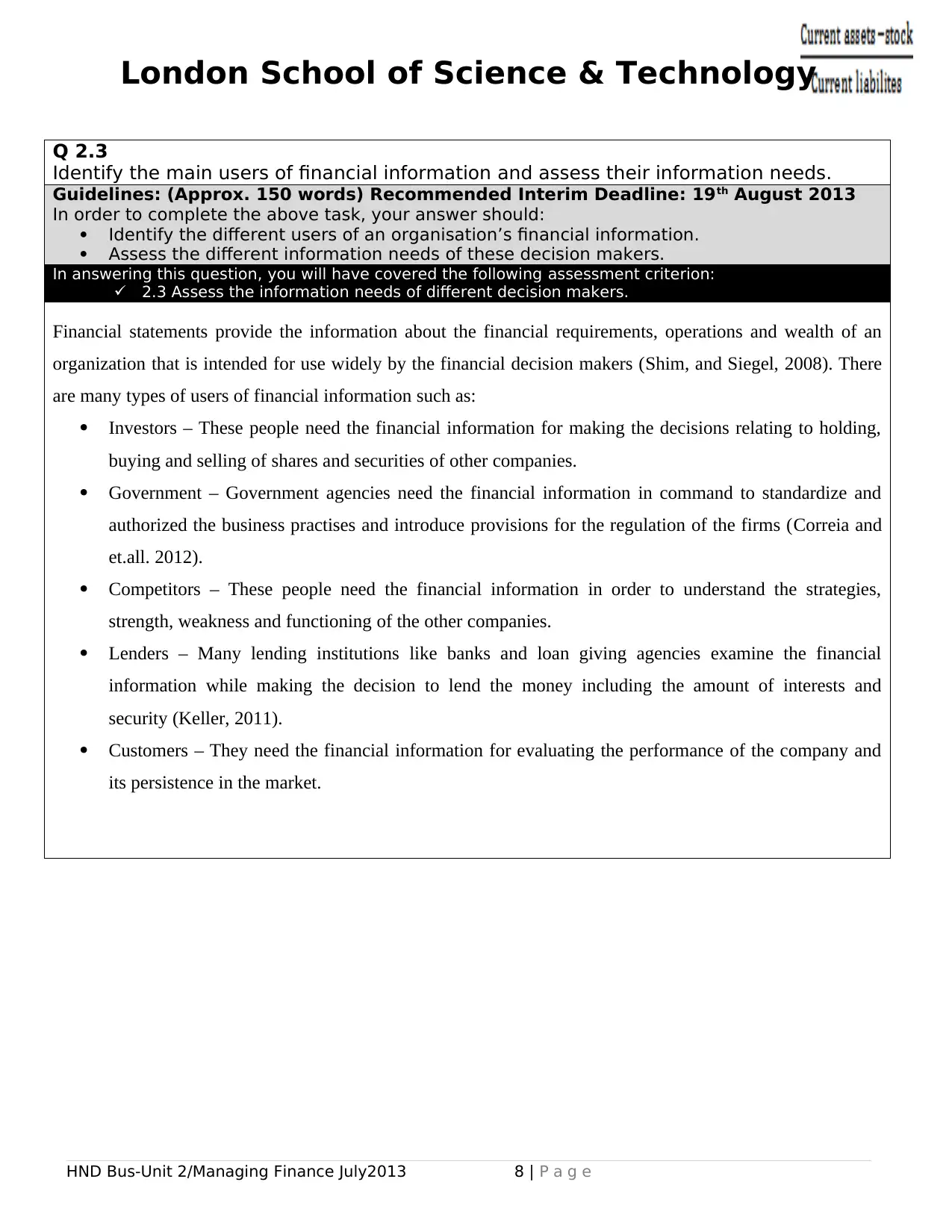
London School of Science & Technology
Q 2.3
Identify the main users of financial information and assess their information needs.
Guidelines: (Approx. 150 words) Recommended Interim Deadline: 19th August 2013
In order to complete the above task, your answer should:
Identify the different users of an organisation’s financial information.
Assess the different information needs of these decision makers.
In answering this question, you will have covered the following assessment criterion:
2.3 Assess the information needs of different decision makers.
Financial statements provide the information about the financial requirements, operations and wealth of an
organization that is intended for use widely by the financial decision makers (Shim, and Siegel, 2008). There
are many types of users of financial information such as:
Investors – These people need the financial information for making the decisions relating to holding,
buying and selling of shares and securities of other companies.
Government – Government agencies need the financial information in command to standardize and
authorized the business practises and introduce provisions for the regulation of the firms (Correia and
et.all. 2012).
Competitors – These people need the financial information in order to understand the strategies,
strength, weakness and functioning of the other companies.
Lenders – Many lending institutions like banks and loan giving agencies examine the financial
information while making the decision to lend the money including the amount of interests and
security (Keller, 2011).
Customers – They need the financial information for evaluating the performance of the company and
its persistence in the market.
HND Bus-Unit 2/Managing Finance July2013 8 | P a g e
Q 2.3
Identify the main users of financial information and assess their information needs.
Guidelines: (Approx. 150 words) Recommended Interim Deadline: 19th August 2013
In order to complete the above task, your answer should:
Identify the different users of an organisation’s financial information.
Assess the different information needs of these decision makers.
In answering this question, you will have covered the following assessment criterion:
2.3 Assess the information needs of different decision makers.
Financial statements provide the information about the financial requirements, operations and wealth of an
organization that is intended for use widely by the financial decision makers (Shim, and Siegel, 2008). There
are many types of users of financial information such as:
Investors – These people need the financial information for making the decisions relating to holding,
buying and selling of shares and securities of other companies.
Government – Government agencies need the financial information in command to standardize and
authorized the business practises and introduce provisions for the regulation of the firms (Correia and
et.all. 2012).
Competitors – These people need the financial information in order to understand the strategies,
strength, weakness and functioning of the other companies.
Lenders – Many lending institutions like banks and loan giving agencies examine the financial
information while making the decision to lend the money including the amount of interests and
security (Keller, 2011).
Customers – They need the financial information for evaluating the performance of the company and
its persistence in the market.
HND Bus-Unit 2/Managing Finance July2013 8 | P a g e
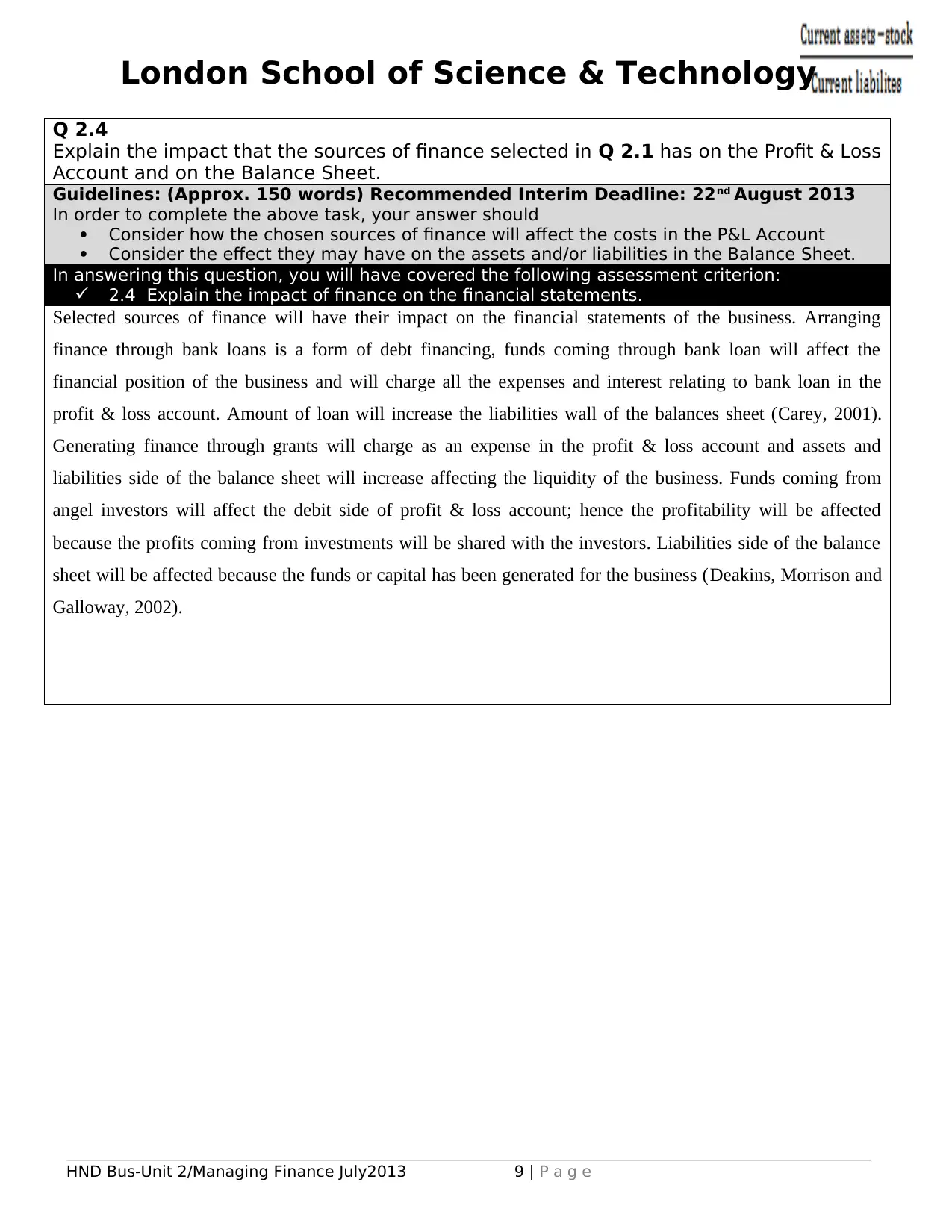
London School of Science & Technology
Q 2.4
Explain the impact that the sources of finance selected in Q 2.1 has on the Profit & Loss
Account and on the Balance Sheet.
Guidelines: (Approx. 150 words) Recommended Interim Deadline: 22nd August 2013
In order to complete the above task, your answer should
Consider how the chosen sources of finance will affect the costs in the P&L Account
Consider the effect they may have on the assets and/or liabilities in the Balance Sheet.
In answering this question, you will have covered the following assessment criterion:
2.4 Explain the impact of finance on the financial statements.
Selected sources of finance will have their impact on the financial statements of the business. Arranging
finance through bank loans is a form of debt financing, funds coming through bank loan will affect the
financial position of the business and will charge all the expenses and interest relating to bank loan in the
profit & loss account. Amount of loan will increase the liabilities wall of the balances sheet (Carey, 2001).
Generating finance through grants will charge as an expense in the profit & loss account and assets and
liabilities side of the balance sheet will increase affecting the liquidity of the business. Funds coming from
angel investors will affect the debit side of profit & loss account; hence the profitability will be affected
because the profits coming from investments will be shared with the investors. Liabilities side of the balance
sheet will be affected because the funds or capital has been generated for the business (Deakins, Morrison and
Galloway, 2002).
HND Bus-Unit 2/Managing Finance July2013 9 | P a g e
Q 2.4
Explain the impact that the sources of finance selected in Q 2.1 has on the Profit & Loss
Account and on the Balance Sheet.
Guidelines: (Approx. 150 words) Recommended Interim Deadline: 22nd August 2013
In order to complete the above task, your answer should
Consider how the chosen sources of finance will affect the costs in the P&L Account
Consider the effect they may have on the assets and/or liabilities in the Balance Sheet.
In answering this question, you will have covered the following assessment criterion:
2.4 Explain the impact of finance on the financial statements.
Selected sources of finance will have their impact on the financial statements of the business. Arranging
finance through bank loans is a form of debt financing, funds coming through bank loan will affect the
financial position of the business and will charge all the expenses and interest relating to bank loan in the
profit & loss account. Amount of loan will increase the liabilities wall of the balances sheet (Carey, 2001).
Generating finance through grants will charge as an expense in the profit & loss account and assets and
liabilities side of the balance sheet will increase affecting the liquidity of the business. Funds coming from
angel investors will affect the debit side of profit & loss account; hence the profitability will be affected
because the profits coming from investments will be shared with the investors. Liabilities side of the balance
sheet will be affected because the funds or capital has been generated for the business (Deakins, Morrison and
Galloway, 2002).
HND Bus-Unit 2/Managing Finance July2013 9 | P a g e
⊘ This is a preview!⊘
Do you want full access?
Subscribe today to unlock all pages.

Trusted by 1+ million students worldwide
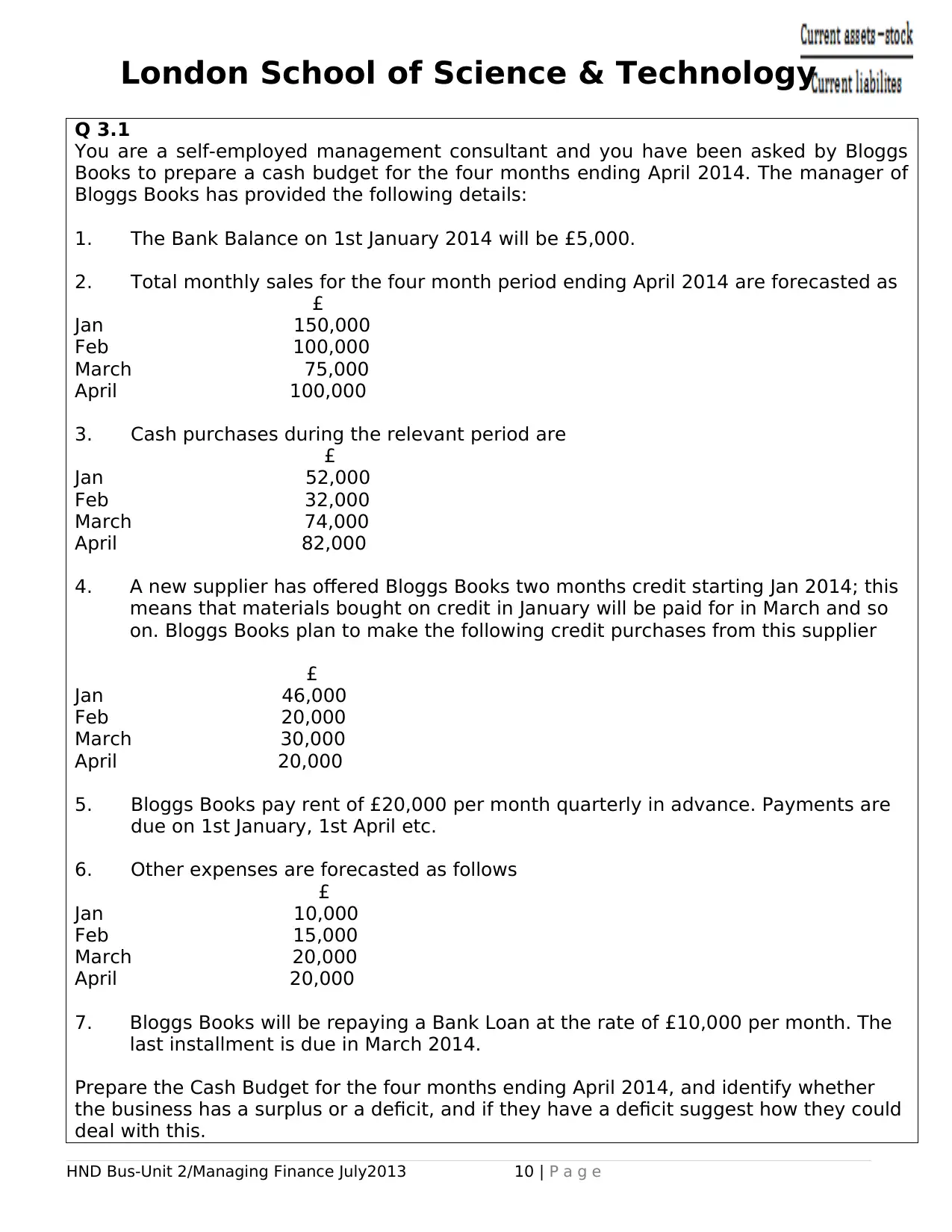
London School of Science & Technology
Q 3.1
You are a self-employed management consultant and you have been asked by Bloggs
Books to prepare a cash budget for the four months ending April 2014. The manager of
Bloggs Books has provided the following details:
1. The Bank Balance on 1st January 2014 will be £5,000.
2. Total monthly sales for the four month period ending April 2014 are forecasted as
£
Jan 150,000
Feb 100,000
March 75,000
April 100,000
3. Cash purchases during the relevant period are
£
Jan 52,000
Feb 32,000
March 74,000
April 82,000
4. A new supplier has offered Bloggs Books two months credit starting Jan 2014; this
means that materials bought on credit in January will be paid for in March and so
on. Bloggs Books plan to make the following credit purchases from this supplier
£
Jan 46,000
Feb 20,000
March 30,000
April 20,000
5. Bloggs Books pay rent of £20,000 per month quarterly in advance. Payments are
due on 1st January, 1st April etc.
6. Other expenses are forecasted as follows
£
Jan 10,000
Feb 15,000
March 20,000
April 20,000
7. Bloggs Books will be repaying a Bank Loan at the rate of £10,000 per month. The
last installment is due in March 2014.
Prepare the Cash Budget for the four months ending April 2014, and identify whether
the business has a surplus or a deficit, and if they have a deficit suggest how they could
deal with this.
HND Bus-Unit 2/Managing Finance July2013 10 | P a g e
Q 3.1
You are a self-employed management consultant and you have been asked by Bloggs
Books to prepare a cash budget for the four months ending April 2014. The manager of
Bloggs Books has provided the following details:
1. The Bank Balance on 1st January 2014 will be £5,000.
2. Total monthly sales for the four month period ending April 2014 are forecasted as
£
Jan 150,000
Feb 100,000
March 75,000
April 100,000
3. Cash purchases during the relevant period are
£
Jan 52,000
Feb 32,000
March 74,000
April 82,000
4. A new supplier has offered Bloggs Books two months credit starting Jan 2014; this
means that materials bought on credit in January will be paid for in March and so
on. Bloggs Books plan to make the following credit purchases from this supplier
£
Jan 46,000
Feb 20,000
March 30,000
April 20,000
5. Bloggs Books pay rent of £20,000 per month quarterly in advance. Payments are
due on 1st January, 1st April etc.
6. Other expenses are forecasted as follows
£
Jan 10,000
Feb 15,000
March 20,000
April 20,000
7. Bloggs Books will be repaying a Bank Loan at the rate of £10,000 per month. The
last installment is due in March 2014.
Prepare the Cash Budget for the four months ending April 2014, and identify whether
the business has a surplus or a deficit, and if they have a deficit suggest how they could
deal with this.
HND Bus-Unit 2/Managing Finance July2013 10 | P a g e
Paraphrase This Document
Need a fresh take? Get an instant paraphrase of this document with our AI Paraphraser
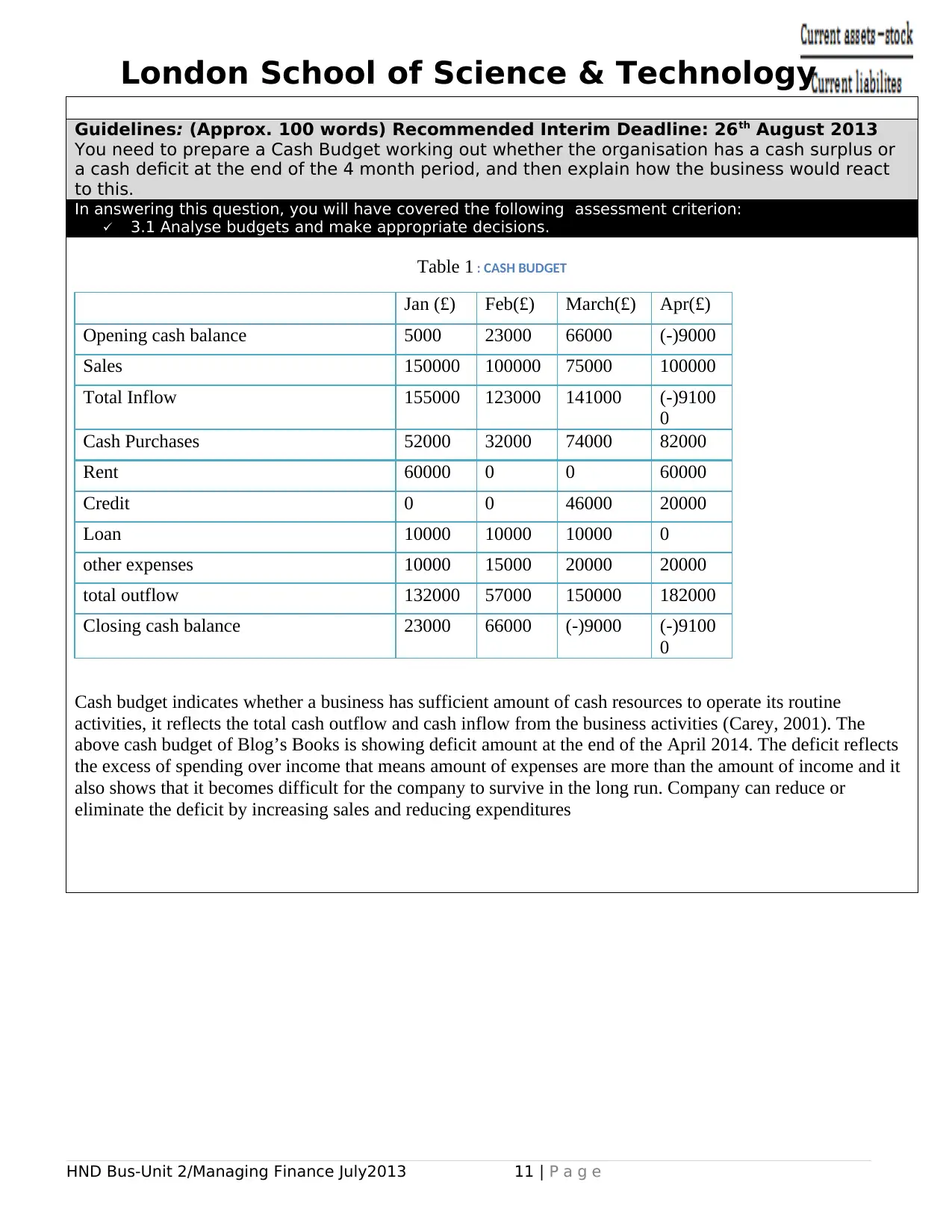
London School of Science & Technology
Guidelines: (Approx. 100 words) Recommended Interim Deadline: 26th August 2013
You need to prepare a Cash Budget working out whether the organisation has a cash surplus or
a cash deficit at the end of the 4 month period, and then explain how the business would react
to this.
In answering this question, you will have covered the following assessment criterion:
3.1 Analyse budgets and make appropriate decisions.
Table 1 : CASH BUDGET
Jan (£) Feb(£) March(£) Apr(£)
Opening cash balance 5000 23000 66000 (-)9000
Sales 150000 100000 75000 100000
Total Inflow 155000 123000 141000 (-)9100
0
Cash Purchases 52000 32000 74000 82000
Rent 60000 0 0 60000
Credit 0 0 46000 20000
Loan 10000 10000 10000 0
other expenses 10000 15000 20000 20000
total outflow 132000 57000 150000 182000
Closing cash balance 23000 66000 (-)9000 (-)9100
0
Cash budget indicates whether a business has sufficient amount of cash resources to operate its routine
activities, it reflects the total cash outflow and cash inflow from the business activities (Carey, 2001). The
above cash budget of Blog’s Books is showing deficit amount at the end of the April 2014. The deficit reflects
the excess of spending over income that means amount of expenses are more than the amount of income and it
also shows that it becomes difficult for the company to survive in the long run. Company can reduce or
eliminate the deficit by increasing sales and reducing expenditures
HND Bus-Unit 2/Managing Finance July2013 11 | P a g e
Guidelines: (Approx. 100 words) Recommended Interim Deadline: 26th August 2013
You need to prepare a Cash Budget working out whether the organisation has a cash surplus or
a cash deficit at the end of the 4 month period, and then explain how the business would react
to this.
In answering this question, you will have covered the following assessment criterion:
3.1 Analyse budgets and make appropriate decisions.
Table 1 : CASH BUDGET
Jan (£) Feb(£) March(£) Apr(£)
Opening cash balance 5000 23000 66000 (-)9000
Sales 150000 100000 75000 100000
Total Inflow 155000 123000 141000 (-)9100
0
Cash Purchases 52000 32000 74000 82000
Rent 60000 0 0 60000
Credit 0 0 46000 20000
Loan 10000 10000 10000 0
other expenses 10000 15000 20000 20000
total outflow 132000 57000 150000 182000
Closing cash balance 23000 66000 (-)9000 (-)9100
0
Cash budget indicates whether a business has sufficient amount of cash resources to operate its routine
activities, it reflects the total cash outflow and cash inflow from the business activities (Carey, 2001). The
above cash budget of Blog’s Books is showing deficit amount at the end of the April 2014. The deficit reflects
the excess of spending over income that means amount of expenses are more than the amount of income and it
also shows that it becomes difficult for the company to survive in the long run. Company can reduce or
eliminate the deficit by increasing sales and reducing expenditures
HND Bus-Unit 2/Managing Finance July2013 11 | P a g e
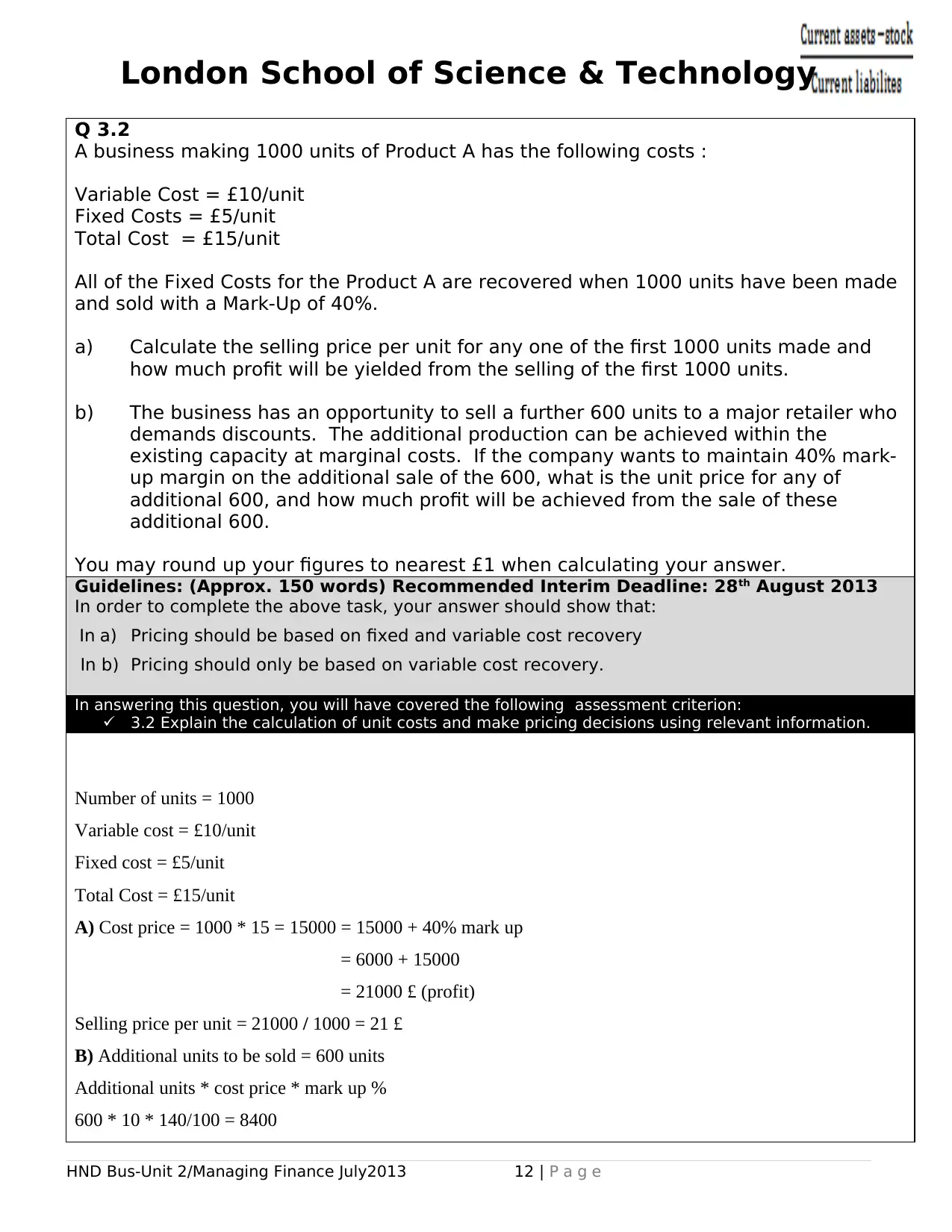
London School of Science & Technology
Q 3.2
A business making 1000 units of Product A has the following costs :
Variable Cost = £10/unit
Fixed Costs = £5/unit
Total Cost = £15/unit
All of the Fixed Costs for the Product A are recovered when 1000 units have been made
and sold with a Mark-Up of 40%.
a) Calculate the selling price per unit for any one of the first 1000 units made and
how much profit will be yielded from the selling of the first 1000 units.
b) The business has an opportunity to sell a further 600 units to a major retailer who
demands discounts. The additional production can be achieved within the
existing capacity at marginal costs. If the company wants to maintain 40% mark-
up margin on the additional sale of the 600, what is the unit price for any of
additional 600, and how much profit will be achieved from the sale of these
additional 600.
You may round up your figures to nearest £1 when calculating your answer.
Guidelines: (Approx. 150 words) Recommended Interim Deadline: 28th August 2013
In order to complete the above task, your answer should show that:
In a) Pricing should be based on fixed and variable cost recovery
In b) Pricing should only be based on variable cost recovery.
In answering this question, you will have covered the following assessment criterion:
3.2 Explain the calculation of unit costs and make pricing decisions using relevant information.
Number of units = 1000
Variable cost = £10/unit
Fixed cost = £5/unit
Total Cost = £15/unit
A) Cost price = 1000 * 15 = 15000 = 15000 + 40% mark up
= 6000 + 15000
= 21000 £ (profit)
Selling price per unit = 21000 / 1000 = 21 £
B) Additional units to be sold = 600 units
Additional units * cost price * mark up %
600 * 10 * 140/100 = 8400
HND Bus-Unit 2/Managing Finance July2013 12 | P a g e
Q 3.2
A business making 1000 units of Product A has the following costs :
Variable Cost = £10/unit
Fixed Costs = £5/unit
Total Cost = £15/unit
All of the Fixed Costs for the Product A are recovered when 1000 units have been made
and sold with a Mark-Up of 40%.
a) Calculate the selling price per unit for any one of the first 1000 units made and
how much profit will be yielded from the selling of the first 1000 units.
b) The business has an opportunity to sell a further 600 units to a major retailer who
demands discounts. The additional production can be achieved within the
existing capacity at marginal costs. If the company wants to maintain 40% mark-
up margin on the additional sale of the 600, what is the unit price for any of
additional 600, and how much profit will be achieved from the sale of these
additional 600.
You may round up your figures to nearest £1 when calculating your answer.
Guidelines: (Approx. 150 words) Recommended Interim Deadline: 28th August 2013
In order to complete the above task, your answer should show that:
In a) Pricing should be based on fixed and variable cost recovery
In b) Pricing should only be based on variable cost recovery.
In answering this question, you will have covered the following assessment criterion:
3.2 Explain the calculation of unit costs and make pricing decisions using relevant information.
Number of units = 1000
Variable cost = £10/unit
Fixed cost = £5/unit
Total Cost = £15/unit
A) Cost price = 1000 * 15 = 15000 = 15000 + 40% mark up
= 6000 + 15000
= 21000 £ (profit)
Selling price per unit = 21000 / 1000 = 21 £
B) Additional units to be sold = 600 units
Additional units * cost price * mark up %
600 * 10 * 140/100 = 8400
HND Bus-Unit 2/Managing Finance July2013 12 | P a g e
⊘ This is a preview!⊘
Do you want full access?
Subscribe today to unlock all pages.

Trusted by 1+ million students worldwide
1 out of 28
Related Documents
Your All-in-One AI-Powered Toolkit for Academic Success.
+13062052269
info@desklib.com
Available 24*7 on WhatsApp / Email
![[object Object]](/_next/static/media/star-bottom.7253800d.svg)
Unlock your academic potential
Copyright © 2020–2025 A2Z Services. All Rights Reserved. Developed and managed by ZUCOL.





